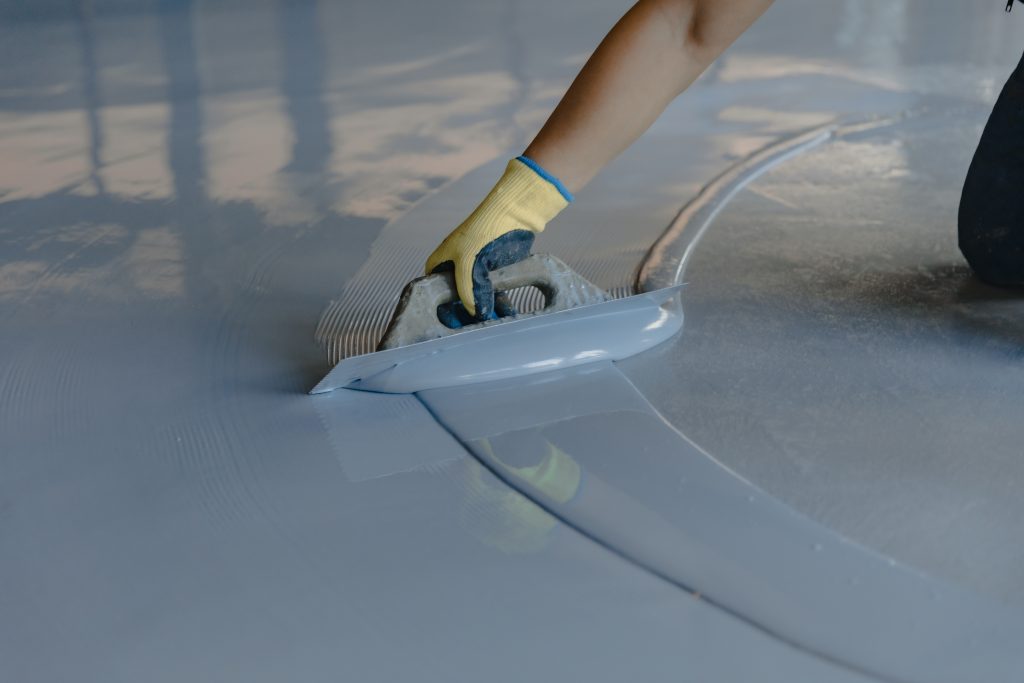GUIDE
How to level the floor for the flooring?
Ceramin

The available methods for levelling a floor are divided into dry and pourable. If you want to level the floor leaving the residues of the old substrate, such as surface coatings, damaged planks or unevenness and chipping, it is worth using a self-levelling screed. This solution will certainly be convenient, but unfortunately it will significantly increase the renovation time, as the water must evaporate from the screed in order to maintain the right conditions for installing the flooring.
Proper preparation of the substrate for the flooring is a very important part of the work. If the flooring is laid on an uneven floor, the first damage to the individual planks will soon appear. This means that the flooring may deform, and stresses can spread unevenly. It is worth remembering that the unevenness should not exceed a few millimetres. The specific distances here will vary depending on the system manufacturer, but contractors also set their standards. Most often, the option that works well is an underlay for the flooring with the thickness of 8 mm. How even the floor is can be checked with a plank. Simply place the plank against the floor and slide it along. If you notice clearances, this means that you need to level the floor for the flooring.
A variety of underlays are used to install the flooring, which are a guarantee of the promises made by the manufacturers. This means that if the flooring without an underlay is damaged, you will not be able to claim a refund. It is therefore worth choosing a suitable underlay for the flooring, as not having one can generate further, significantly higher costs. If you decide not to use an underlay, you will also reduce the durability and damage resistance of the flooring. Remember that under heavier loads, the lack of an underlay can even cause cracks in the structure of the flooring. In addition, the lack of an underlay also affects the acoustics of the room, which is much less efficient.
Rubber mats for the flooring are ideal for those who want a quick and easy installation of the underlay. Mats guarantee a long lifespan and the possibility of repeated use. They allow to achieve full resistance to damage and effectively insulate the room from impact sounds. In addition, they provide proper acoustic insulation, vibration isolation and safety during use. On the market you can also find a water-resistant underlay for the flooring with the thickness of 15 mm, which is characterised by high resistance to damage and deformation. In addition, mats of this type also provide adequate flexibility, thanks to which they effectively dampen unwanted sounds. They also easily adapt to any surface.
This type of underlay is renowned for its good sound insulating properties. In addition, it protects against uncontrolled heat transfer, so it is ideal for rooms above cooler floors. It is worth taking into consideration, however, that it will not be suitable for underfloor heating. The cork underlay for the flooring is flexible and can withstand loads well. On the other hand, it is quite easy to break and damage it, so it is not suitable for heavily used areas. It is also worth adding that cork does not absorb moisture and is resistant to mould.
This underlay is ideal for underfloor heating. Polystyrene perfectly retains heat and protects the individual layers of the floor against moisture. It also dampens noise well and is also characterised by high durability.
Quartz mats are renowned for their excellent sound insulation. The underlay for the flooring with the thickness of 15 mm makes the material absorb sound well and has high load resistance. It is ideal for the laminate flooring. Thanks to its low thermal resistance, it is also suitable for underfloor heating systems. What is more, it levels out spot unevenness of the substrate.
Other underlays that can be used for the flooring include epoxy or polyurethane resin. This material is often used as the top, decorative layer of the floor, which confirms its durability. Resin is also ideal for those who want a fast result, as it dries much faster than self-levelling screed. This makes it a stable and durable surface, which is perfect for levelling out any damage or cracks in the floor. Another way of levelling the floor for the flooring is to use wood-based boards that make it easier to create a structure, such as OSB. They are characterised by strength and stability, moreover, they do not crack. They work best when laid over old planks. Another way can be the use of dry screed boards, such as plasterboard or concrete boards. Such boards will not only level out uneven sections of the substrate, but will also make it easier to install the flooring.
Levelling the substrate before the installation of the flooring is very important, not only to extend the lifespan of the floor, but also to make the laying process easier. We have presented the most popular underlays for the flooring, which will do the job perfectly.